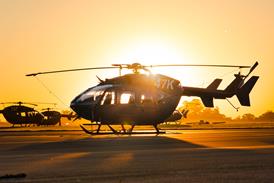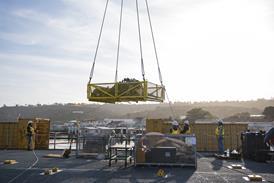Boeing's efforts to establish the 717-200 in the marketplace were boosted on 24 February with the first flight of the premier production example, P-1, at its Long Beach division in California.
Even as P-1 lifted off to join the test programme in the cream and green livery of AirTran, Boeing revealed studies to be undertaken on a series of improvements to reduce the take-off and landing distance of the 100-seat twinjet to increase the number of airports into which it can operate.
News of the studies also coincided with the release of the first performance details for the baseline aircraft, which is demonstrating a substantial (5%) fuel consumption reduction in the cruise compared to predicted performance.
"That's very good news," says 717 programme director Jerry Callaghan, who adds that the climb fuel consumption rate is about 3% better than expected. Taken with the cruise improvement, Boeing estimates that the average fuel consumption benefit is likely to be 3-4.5% for the complete flight, depending on the length of the route. "For this kind of aircraft, it will translate into better direct operating costs," says Callaghan, who also claims that "-for ranges over around 500nm [925km], it will mean better mileage".
Flight test dataThe newly quantified data result from the initial flight test programme which has covered about 700h of the 1,700h total planned before certification. The three aircraft in the test effort are 75% through the development work, and 25% through certification tests. US Federal Aviation Administration and European Joint Aviation Authorities certification is expected around August, with initial deliveries to launch customer AirTran following in September. AirTran is due to take eight 717s in 1999, with a further 12 due in 2000, 12 in 2001 and 18 in 2002. The airline has firm orders for 50 and options on a further 50.
The better than expected performance is largely because of lower than predicted interference drag around the empennage. "With those big engines, we expected a complex flow field around the back of the aircraft, and that could come up and bite you in terms of interference drag. However, that is clearly better than expected and the engine performance has come out better than predicted as well," says Callaghan. In engine cell tests, BMW Rolls-Royce says the BR715 turbofan has a fuel consumption 1-1.5% lower than the original estimates.
Flight tests have also revealed that the buffet boundary is between 500ft (150m) and 1,000ft higher than expected, meaning that initial cruise and step altitude capability is also increased. "This will certainly be more meaningful for those intending to operate it on ranges up to 1,500nm," says Callaghan, who adds that the new performance data will be injected directly into the renewed marketing efforts now being undertaken.
Weight is also "at specification with margin", he adds. Although no specific figures have been mentioned, the margin is believed to be several hundred pounds, despite the late increase in empty weight caused by the revised containment system for the BR715. Noise and emissions are also within target, with noise "well below whatever Stage 4 levels we will eventually have", adds Callaghan.
Field performance
Although low-speed performance is also "equal to, or better than, expected", the improved field performance studies are being pursued to increase sales potential. These studies include the use of an optional 50¼ flap setting, to reduce landing length, and greater rudder throw, to maintain minimum control speed with one engine out. This would allow Boeing to fit an uprated BR715 rated at around 89kN (20,000lb) thrust compared to the standard 18,500lb-thrust engine.
The upgrade would also make use of actuators which have been added to cure a problem encountered during flight tests. With flaps set at 50¼, the test team discovered a "spoiler float" issue. Actuators were fitted to hold down the spoilers mechanically, while the flap setting was restricted to 40¼. The actuators also countered a potential single-point failure mode in the fly-by-wire controlled system in which the spoilers could deploy uncommanded.
The test aircraft are also being used to evaluate a beefed-up braking/anti-skid combination developed by AlliedSignal and Hydroair. The original system exhibited high-frequency vibration, which the replacement system has been designed to eliminate or reduce significantly. Boeing is also working with Honeywell on software issues with the autoflight system, which is being developed for Category IIIB operations.
Cabin noise
Boeing is working on a noise issue in the aft cabin. Potential solutions include active noise cancellation systems, which automatically counteract vibration at the engine mounts, and which are successfully used on the McDonnell Douglas DC-9, one of the 717's predecessors.
For the longer term, Boeing is studying further family developments. Based on market research, it believes that demand for a shortened 717-100 is relatively strong in Europe. It is also keen to step up studies of the stretched 717-300, which would be aimed primarily at the North American market.o
Above: Boeing hopes to increase the number of airports the 717 can operate in by studying ways to reduce the 100-seat twinjet's take-off and landing distances
Source: Flight International























